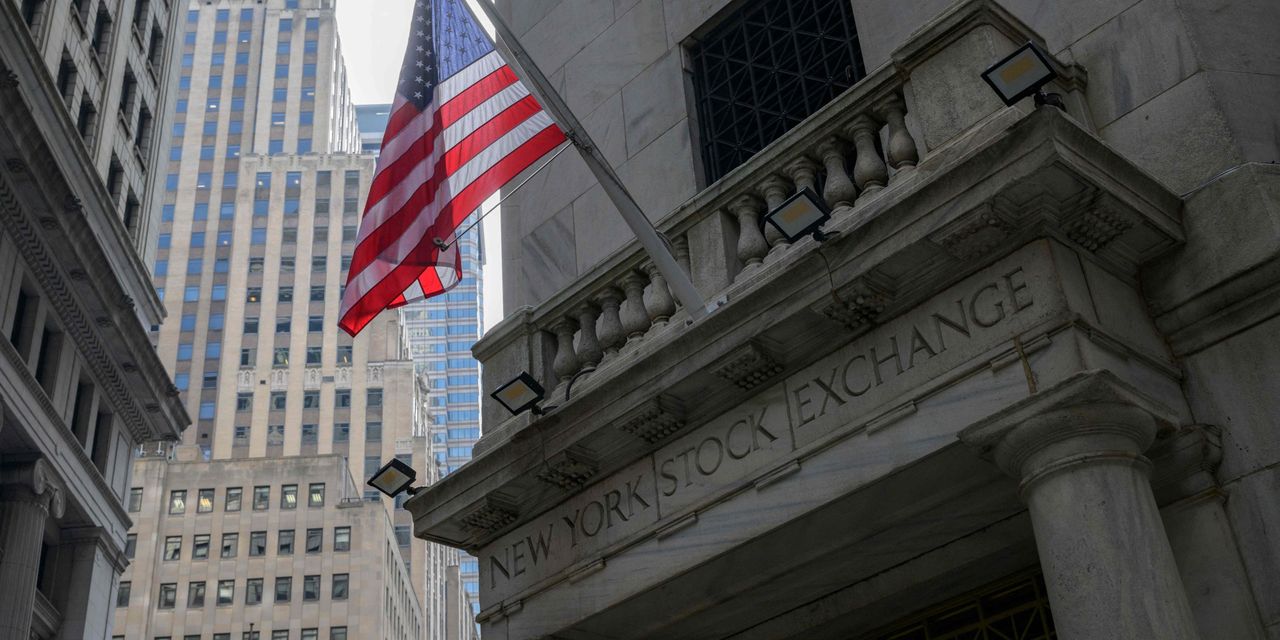U.S. stocks finished mostly lower on Monday, with the Dow Jones and S&P 500 each falling to almost five-month lows, even after the 10-year Treasury yield pulled back from 5%.
How stocks traded
-
The Dow Jones
DJIA
ended down by 190.87 points, or 0.6%, at 32,936.41 after having dropped by as much as 235 points during the New York session. It finished down for the fourth straight trading session. -
The S&P 500
SPX
closed down by 7.12 points, or almost 0.2%, at 4,217.04. The index finished down for a fifth straight session, matching the five-session losing streak it had during the period that ended on Dec. 7. - Monday’s levels were the lowest closes for the Dow Jones and S&P 500 since May 31.
-
The Nasdaq Composite
COMP
rose 34.52 points, or 0.3%, to 13,018.33.
The Dow fell 1.6% last week, while the S&P 500 declined 2.4% and the Nasdaq Composite shed 3.2%. All three major indexes saw their biggest declines since the week that ended Sept. 22. On Friday, the S&P 500 also had its first close below its 200-day moving average since March.
What drove markets
The 10-year Treasury yield
BX:TMUBMUSD10Y
finished at a one-week low of almost 4.84% on Monday, after having briefly pushed above 5% to touch its highest level in 16 years earlier in the day. On Friday, the 10-year yield had its biggest weekly rise since April amid repeated rounds of selloffs.
“We’re seeing a lot of volatility in the bond market, with a lot of investors seeing the move above 5% on the 10-year yield as a little excessive given current views of where the economy is,” said Edward Moya, a senior market analyst for the Americas at OANDA Corp. in New York.
Stocks were initially helped by Monday’s retreat in yields after Pershing Square’s Bill Ackman tweeted that he has closed his bet against 30-year Treasury bonds. Ackman said he closed the trade because “there is too much risk in the world to remain short bonds at current long-term rates,” and because “the economy is slowing faster than recent data suggests.”
Read: Bill Ackman cashes out bet against Treasury bonds as yields hit 16-year highs
A sharp rise in yields has dogged the stock market since the S&P 500 set its 2023 peak at the end of July.
According to OANDA’s Moya, “this is the earnings season where the outlooks are going to become a little bit better and we are going to see all the bad news has already been priced in.” In addition, he said via phone on Monday, “it seems the market is a little bit optimistic that we are not going to see an immediate escalation in the Middle East conflict.”
On Monday, Bloomberg reported that there are calls inside Israel to rethink the parameters of the country’s anticipated ground invasion in Gaza. Citing people familiar with the discussions of Israeli Prime Minister Benjamin Netanyahu’s war cabinet, Bloomberg cited numerous concerns that included fears that Hezbollah in Lebanon will enter the conflict, the risk of Israeli military casualties, and the fate of about 200 hostages.
Oil futures
CL.1,
BRN00,
settled lower on Monday, with Brent oil ending below $90 a barrel.
“For now, everyone is on pins and needles and asking if there can there be a peaceful, calm resolution in the Middle East. But I don’t think anyone has a great handle on anything at the moment,” said Mark Neuman, founder of Atlanta-based Constrained Capital.
Neuman also said there are “a lot more unknowns than knowns at the moment, and you’ve got wrestling forces because it seems the bond market is driving a lot of things, with China and Japan being forced to sell Treasurys.”
In One Chart: Why a 5% Treasury yield sends a gloomy stock-market message right now
The data calendar was empty for Monday, but this week brings updates on the housing market, growth and the Fed’s preferred inflation gauge, also known as the personal consumption expenditures price index, which is due out Friday.
On the earnings front, an important batch of results is rolling out this week that could determine the course of the remaining third-quarter earnings season, with Microsoft Corp.
MSFT,
and Google parent Alphabet Inc.
GOOGL,
reporting Tuesday, Meta Platforms Inc.
META,
reporting Wednesday and Amazon.com Inc.
AMZN,
on Thursday. Market optimism has wavered following mixed bank earnings.
Read: Big-tech results will decide ‘where we go from here’ amid investor caution. They would fall if it weren’t for this one company.
Companies in focus
-
Chevron Corp.
CVX,
-3.69%
said Monday that it’s reached a deal to buy Hess Corp.
HES,
-1.06%
in an all-stock agreement valued at $53 billion, or $171 per share. Chevron shares finished down by 3.7%, while Hess shares closed down by 1.1%. -
Tesla Inc.
TSLA,
+0.04%
is voluntarily recalling almost 55,500 Model X electric vehicles made in the past two years, as the vehicles’ controllers may fail to detect low brake fluid and not display a warning light. Separately, Tesla said in a 10-Q filing on Monday that it expects capital expenditures for this year to exceed $9 billion. Shares closed less than 0.1% higher. -
Shares of Walgreens Boots Alliance Inc.
WBA,
+3.29%
finished 3.3% higher after JPMorgan turned bullish on the healthcare-services and pharmacy chain, based on the expectation that the new chief executive will help remove the overhangs that have been hurting the stock. -
Okta Inc.’s Class A shares
OKTA,
-8.14%
ended 8.1% lower as analysts assessed the potential fallout from a recently disclosed data breach. On Friday, the company disclosed a security breach that occurred when hackers got access to a stolen credential and were able to see files related to some support cases.
Barbara Kollmeyer contributed.
Read the full article here





